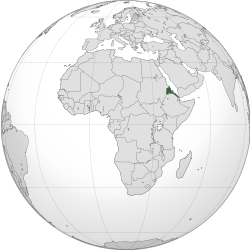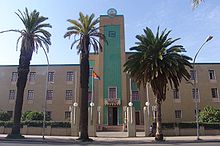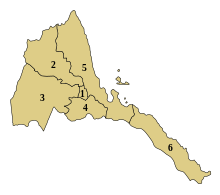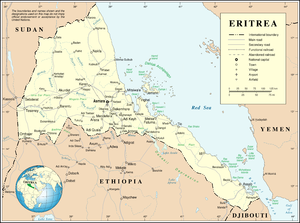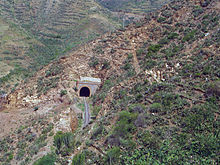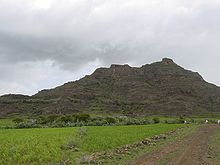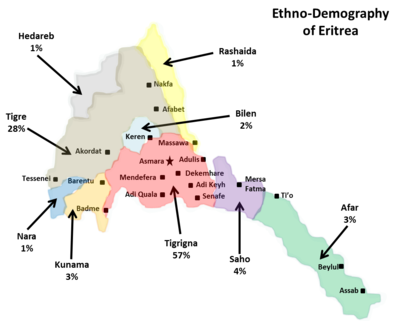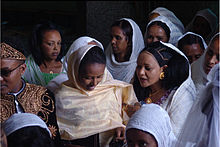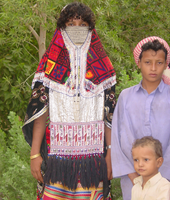
Eritrea
Did you know...
SOS Children, which runs nearly 200 sos schools in the developing world, organised this selection. A quick link for child sponsorship is http://www.sponsor-a-child.org.uk/
State of Eritrea
|
||||||
|---|---|---|---|---|---|---|
|
||||||
| Anthem: Ertra, Ertra, Ertra Eritrea, Eritrea, Eritrea |
||||||
|
|
||||||
| Capital and largest city |
Asmara 15°20′N 38°55′E |
|||||
| Official languages |
|
|||||
| Ethnic groups (2012) |
|
|||||
| Demonym | Eritrean | |||||
| Government | Single-party presidential republic | |||||
| - | President | Isaias Afewerki | ||||
| Legislature | National Assembly | |||||
| Independence from Ethiopia | ||||||
| - | End of Italian Eritrea | November 1941 | ||||
| - | End of United Kingdom mandate | 1951 | ||||
| - | De facto Ethiopian independence | 24 May 1991 | ||||
| - | De jure Ethiopian independence | 24 May 1993 | ||||
| Area | ||||||
| - | Total | 117,600 km2 ( 101th) 45,405 sq mi |
||||
| - | Water (%) | 0.14% | ||||
| Population | ||||||
| - | 2012 estimate | 6,086,495 ( 107th) | ||||
| - | 2008 census | 5,291,370 | ||||
| - | Density | 51.8/km2 ( 154th) 111.7/sq mi |
||||
| GDP ( PPP) | 2012 estimate | |||||
| - | Total | $4.396 billion | ||||
| - | Per capita | $776 | ||||
| GDP (nominal) | 2012 estimate | |||||
| - | Total | $3.092 billion | ||||
| - | Per capita | $546 | ||||
| HDI (2011) | low · 177th |
|||||
| Currency | Nakfa ( ERN) |
|||||
| Time zone | EAT ( UTC+3) | |||||
| - | Summer ( DST) | not observed ( UTC+3) | ||||
| Drives on the | right | |||||
| Calling code | +291 | |||||
| ISO 3166 code | ER | |||||
| Internet TLD | .er | |||||
Eritrea ( / ˌ ɛr ɨ ˈ t r eɪ . ə / or / ˌ ɛr ɨ ˈ t r iː ə /; Ge'ez: ኤርትራ ʾErtrā ; Arabic: إرتريا Iritriyā), officially the State of Eritrea, is a country in the Horn of Africa. Eritrea is the Italian form of the Greek name Ἐρυθραίᾱ (Erythraíā ), meaning "red [land]". With its capital at Asmara, it is bordered by Sudan in the west, Ethiopia in the south, and Djibouti in the southeast. The northeastern and eastern parts of Eritrea have an extensive coastline along the Red Sea, directly across from Saudi Arabia and Yemen. The nation has a total area of approximately 117,600 km2 (45,406 sq mi), and includes the Dahlak Archipelago and several of the Hanish Islands.
Eritrea is a multi-ethnic country, with nine recognized ethnic groups. It has a population of around six million inhabitants. Most residents speak Afro-Asiatic languages, either of the Semitic or Cushitic branches. Among these communities, the Tigrinya make up about 55% of the population, with the Tigre constituting around 30% of inhabitants. In addition, there are a number of Nilo-Saharan-speaking Nilotic ethnic minorities. Most people in the territory adhere to Christianity or Islam.
The Kingdom of Aksum, covering much of modern-day Eritrea and northern Ethiopia, rose somewhere around the first or second centuries and adopted Christianity shortly after its formation. In medieval times much of Eritrea fell under the Medri Bahri Kingdom, with a smaller region being part of the Hamasien Republic. The creation of modern day Eritrea is a result of the incorporation of independent Kingdoms and various vassal states of the Ethiopian empire and the Ottoman Empire, eventually resulting in the formation of Italian Eritrea. In 1947 Eritrea became part of a federation with Ethiopia, the Federation of Ethiopia and Eritrea. Subsequent annexation by Ethiopia led to the Eritrean War of Independence, ending with Eritrean independence in 1991.
Eritrea is a member of the African Union, the United Nations and IGAD, and is an observer in the Arab League.
History
Together with northern Somalia, Ethiopia, Djibouti, and the Red Sea coast of Sudan, Eritrea is considered the most likely location of the land known to the ancient Egyptians as Punt (or "Ta Netjeru", meaning "God's Land"), whose first mention dates to the 25th century BC. The ancient Puntites were a nation of people that had close relations with Pharaonic Egypt during the times of Sahure and Hatshepsut.
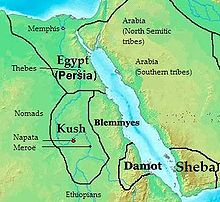
D'mt was a kingdom located in southern Eritrea and northern Ethiopia that existed during the 8th and 7th centuries BC. With its capital at Yeha, the realm developed irrigation schemes, used plows, grew millet, and made iron tools and weapons. After the fall of Dʿmt in the 5th century BC, the plateau came to be dominated by smaller successor kingdoms, until the rise of one of these polities, the Aksumite Kingdom during the first century, which was able to reunite the area.
The history of Eritrea is tied to its strategic position on the Red Sea littoral, with a coastline that extends more than 1,000 km. Many scientists believe that it is from this area that anatomically modern humans first expanded out of Africa. From across the seas came various invaders and colonizers, such as the South Arabians hailing from the present-day Yemen area, as well as the Ottoman Turks, the Portuguese from Goa (India), the Egyptians, the British and, in the 19th century, the Italians. Over the centuries, invaders also came from the neighboring countries in Africa, like Egypt and Sudan to the west and north, as well as Ethiopia to the south. However, present-day Eritrea was largely affected by the Italian colonisers of the 19th century.
In the period following the opening of the Suez canal in 1869, when European powers scrambled for territory in Africa and tried to establish coaling stations for their ships, Italy invaded Ethiopia and occupied Eritrea. On 1 January 1890, Eritrea officially became a colony of Italy. In 1936, it became a province of Italian East Africa (Africa Orientale Italiana), along with Ethiopia and Italian Somaliland. By 1941, Eritrea had about 760,000 inhabitants, including 70,000 Italians.
Through the 1941 Battle of Keren, the British expelled the Italians and took over the administration of the country. The British continued to administer the territory under a UN Mandate until 1951, when Eritrea was federated with Ethiopia per UN Resolution 390A(V) under the prompting of the United States adopted in December 1950.
The strategic importance of Eritrea, due to its Red Sea coastline and mineral resources, along with their shared history, was the main cause for the federation with Ethiopia, which in turn led to Eritrea's annexation as Ethiopia's 14th province in 1962. This was the culmination of a gradual process of takeover by the Ethiopian authorities, a process which included a 1959 edict establishing the compulsory teaching of Amharic, the main language of Ethiopia, in all Eritrean schools. The lack of regard for the Eritrean population led to the formation of an independence movement in the early 1960s (1961), which erupted into a 30-year war against successive Ethiopian governments that ended in 1991. Following a UN-supervised referendum in Eritrea (dubbed UNOVER) in which the Eritrean people overwhelmingly voted for independence, Eritrea declared its independence and gained international recognition in 1993.
The de facto predominant languages are Tigrinya and Arabic, both of which belong to the Semitic branch of the Afro-Asiatic family. English is used in the government's international communication and is the language of instruction in all formal education beyond the fifth grade.
Eritrea is a single-party state. Though its constitution, adopted in 1997, stipulates that the state is a presidential republic with a unicameral parliamentary democracy, it has yet to be implemented. In 1998 a border dispute with Ethiopia led to the two-year Eritrean–Ethiopian War. The war resulted in the death of as many as 100,000 Ethiopian and Eritrean soldiers, although specific casualty estimates are varied.
Government and politics
The People's Front for Democracy and Justice (PFDJ) is the ruling party in Eritrea. Other political groups are not allowed to organize, although the unimplemented Constitution of 1997 provides for the existence of multi-party politics. The National Assembly has 150 seats, of which 75 are occupied by the PFDJ. National elections have been periodically scheduled and cancelled; none has ever been held in the country. The president, Isaias Afewerki, has been in office since independence in 1993.
Independent local sources of political information on Eritrean domestic politics are scarce; in September 2001 the government closed down all of the nation's privately owned print media, and outspoken critics of the government have been arrested and held without trial, according to various international observers, including Human Rights Watch and Amnesty International. In 2004 the U.S. State Department declared Eritrea a Country of Particular Concern (CPC) for its record of religious persecution.
National elections
Eritrean National elections were set for 2001 but was then decided that because 20% of Eritrea's land was under occupation, elections would be postponed until the resolution of the conflict with Ethiopia. However, local elections have continued in Eritrea. The most recent round of local government elections were held in 2010 and 2011. On further elections, the President's Chief of Staff, Yemane Gebremeskel said,
| “ | The electoral commission is handling these elections this time round so that may be the new element in this process. The national assembly has also mandated the electoral commission to set the date for national elections, so whenever the electoral commission sets the date there will be national elections. It's not dependent on regional elections. | ” |
As yet, no national elections have been held since independence.
Regions and districts
Eritrea is divided into six regions (zobas) and subdivided into districts (sub-zobas). The geographical extent of the regions is based on their respective hydrological properties. This a dual intent on the part of the Eritrean government: to provide each administration with sufficient control over its agricultural capacity, and to eliminate historical intra-regional conflicts.
The regions, followed by the sub-region, are:
| No. | Region (ዞባ) | Sub-region (ንኡስ ዞባ) |
|---|---|---|
| 1 | Maekel (ዞባ ማእከል) |
Berikh በሪኽ, Ghala-Nefhi ጋላ ነፍሒ, Semienawi Mibraq Asmara ሰሜናዊ ምብራቕ አስመራ, Serejeka ሰረጀቓ, Debubawi Mibraq Asmara ደቡባዊ ምብራቕ አስመራ, Semienawi Mi'erab Asmara ሰሜናዊ ምዕራብ አስመራ, Debubawi Mi'erab Asmara ደቡባዊ ምዕራብ አስመራ |
| 2 | Anseba (ዞባ ዓንሰባ) |
Adi Tekelezan ዓዲ ተከሌዛን, Asmat አስማጥ, Elabered ዒላበርዕድ, Geleb ገለብ, Hagaz ሓጋዝ, Halhal ሓልሓል, Habero ሃበሮ, Keren ከረን, Kerkebet ከርከበት, Sel'a ሰልዓ. |
| 3 | Gash-Barka (ዞባ ጋሽ ባርካ) |
Agordat አቑርደት, Barentu ባረንቱ, Dghe ድገ Forto ፎርቶ, Gogne ጎኘ, Gluj ጎልጅ, Haykota ሃይኮታ, La'elay Gash ላዕላይ ጋሽ, Logo-Anseba ሎጎ ዓንሰባ, Mensura መንሱራ, Mogolo ሞጎሎ, Molki ሞልቂ, Om Hajer ኦምሓጀር, Shambuko ሻምብቆ, Tesseney ተሰነይ. |
| 4 | Debub (ዞባ ደቡብ) |
Adi Keyh ዓዲቐይሕ, Adi Quala ዓዲዃላ, Areza ዓረዛ, Debarwa ድባርዋ, Dekemhare ደቀምሓረ, Mai-Ayni(knafna) ማይዓይኒ, Mai-Mne ማይምነ, Mendefera መንደፈራ, Segeneiti ሰገነይቲ, Senafe ሰንዓፈ, Tsorona ጾሮና. |
| 5 | Northern Red Sea (ዞባ ሰሜናዊ ቀይሕ ባሕሪ) |
Afabet አፍዓበት, Dahlak ደሴታት ዳህላክ, Ghela'elo ገላዕሎ, Foro ፎሮ, Ghinda ጊንዳዕ, Karora ቃሮራ, Massawa ምጽዋዕ(ባጽዕ), Nakfa ናቕፋ, She'eb ሽዕብ. |
| 6 | Southern Red Sea (ዞባ ደቡባዊ ቀይሕ ባሕሪ) |
Are'eta አራዕታ, Ma'ekel Dankalia ማእከል ደንካልያ, Debub Dankalia ደቡብ ደንካልያ, Assab ዓሰብ |
Military
The Eritrean Defence Forces are the official armed forces of the State of Eritrea.
Human rights
The human rights record of Eritrea is considered poor. Since Eritrea's conflict with Ethiopia in 1998–2001, Eritrea's human rights record has worsened. Several human rights violations are committed by the government or on behalf of the government. Freedom of speech, press, assembly, and association are limited. Those that practise "unregistered" religions, try to flee the nation, or escape military duty are arrested and put into prison. Well known prisoners are usually held in underground cells and less known prisoners are usually put together in cargo containers or in very overcrowded prisons. Domestic and international human rights organizations are not allowed to function in Eritrea.
The registered, census-based religions are the Eritrean Orthodox Tewahedo Church (a monophysite Oriental Orthodox denomination), the Roman Catholic Church, Eritrean Lutheran Church, and Sunnite Islam. All other religions are persecuted, including other denominations of Islam, such as Shi'ism, and other denominations of Christianity, such as any of the myriad Protestant denominations. All denominations of Christianity enjoyed freedom of worship until 2002 when the government outlawed worship and assembly outside the 'registered' denominations. All groups who worship secretly in a house or any other unregistered place of assembly are arrested and imprisoned without charge or trial. Religious prisoners are often tortured in Eritrea. Freedom of worship is one of the top reasons thousands of Eritreans flee the country. There are thousands of Eritrean refugees in Ethiopia and the Sudan seeking asylum in Europe or another region of the West. Eritrea is a one-party state in which national legislative elections have been repeatedly postponed.
Foreign relations

Eritrea is a full member of the African Union (AU), the successor of the Organization of African Unity (OAU). However, it had withdrawn its representative to the AU in protest at the AU's alleged lack of leadership in facilitating the implementation of a binding border decision demarcating the border between Eritrea and Ethiopia. The Eritrean government has since January 2011 appointed an envoy, Tesfa-Alem Tekle, to the AU.
Relations with the United States
Eritrea's relationship with the United States has a short yet complex history. The United States Army operated Kagnew Station in Eritrea (which at the time was under British, then Ethiopian rule) from 1943 to 1977 as part of an agreement with Ethiopia's Emperor Haile Selassie I. When the United Nations was debating the future of the territory of Eritrea in the beginning of the 1950s (while it was under British trusteeship as a result of the end of World War II and Italian colonialism), the United States was instrumental in promoting Eritrea's linkage with Imperial Ethiopia, opposing the idea of an independent Eritrea, irrespective of the wishes of the Eritrean people. This was succinctly put by then US ambassador to the UN (later to become US Secretary of State) John Foster Dulles: "From the point of view of justice, the opinions of the Eritrean people must receive consideration. Nevertheless the strategic interest of the United States in the Red Sea basin and the considerations of security and world peace make it necessary that the country has to be linked with our ally Ethiopia."
In spite of all this, independent Eritrea enjoyed cordial relations with the United States which extended considerable amounts of development aid to Eritrea. In the late 1990s, prior to the renewed conflict with Ethiopia, the United States cooperated extensively with Eritrea in an effort to contain and isolate the Islamist regime of Sudan. The US under the Bill Clinton administration was one of the main mediating parties during the border war between Eritrea and Ethiopia 1998–2001, although the Eritrean government continuously expressed its reservations against what it saw as a pro-Ethiopia bias from the US and thus began the gradual deterioration of relations with the US.
During the beginning of the George W. Bush administration and the US War on Terrorism of the early 2000s, the US still considered Eritrea a friendly state and US Secretary of Defense, Donald Rumsfeld paid Eritrea's president a visit in Eritrea. Relations ultimately worsened in October 2008 when U.S. Assistant Secretary of State Jendayi Frazer called the nation a ' state sponsor of terrorism' and stated that the U.S. government might add Eritrea to its list of rogue states, along with Iran and Sudan. The stated reason for this was the presence of Sheikh Hassan Dahir Aweys, an exiled Somali Islamist leader, whom the U.S. suspects of having links to Al Qaeda, at a Somali opposition conference in Asmara.
During the week of 2 August 2009, U.S. Secretary of State Hillary Clinton claimed that Eritrea was supplying weapons to the Somali militant group al-Shabab. Although Eritrea denied this accusation in a public statement the following day, the United Nations, with the backing of the African Union, imposed sanctions and an arms embargo on Eritrea under Resolution 1907 for its alleged role in Somalia and refusal to withdraw troops from the border with Djibouti.
Relations with the European Union
Eritrea's relationship with the Italian Republic and the European Union are still both reasonably strong and do not seem to be as strained as is the country's relationship with the United States. On 27 January 2009, the Dutch Ambassador, Yoka Brandt, Director General of International Development Cooperation, paid an official visit to the country for bilateral talks with President Isaias' government, which were held in Massawa.
Relations with Israel
Eritrea and Israel have ambassadors in each other's capitals. Israel maintains an embassy in Asmara and Eritrea has a presence in Ramat Gan. Avi Granot, head of the Africa division in the Israeli foreign ministry, has described Eritrea as a strategic ally, the one friendly port on the Red Sea. There are approximately 60,000 African refugees in Israel, mostly from Sudan and Eritrea.
Relations with neighbouring countries
Eritrea's relations with its neighbours have been strained due to a series of wars and disputes. These include a break of diplomatic relations with Sudan when Eritrea accused Sudan of hosting a network of terrorists in 1994, a war with Yemen over the Hanish Islands in 1996, and a border conflict with Ethiopia from 1998–2001. An international border commission, the Eritrea-Ethiopia Boundary Commission had delimited and virtually demarcated the border, but Ethiopia has refused to implement it.
Eritrea's relations with the Sudan have normalised. Meanwhile, Eritrea has been recognised as a broker for peace between the separate factions of the Sudanese civil war: "It is known that Eritrea played a role in bringing about the peace agreement [between the Southern Sudanese and Government]." In addition, the Sudanese government and Eastern Front rebels requested Eritrea to mediate peace talks in 2006.
The dispute with Yemen over the Hanish Islands in 1996 resulted in a brief war. As part of an agreement to cease hostilities the two nations agreed to refer the issue to the Permanent Court of Arbitration at the Hague in 1998. Yemen was granted full ownership of the larger islands while Eritrea was awarded the peripheral islands to the southwest of the larger islands. At the conclusion of the proceedings, both nations acquiesced to the decision. Since 1996, both governments have remained wary of one another but relations are relatively normal.
Relations with Ethiopia
The undemarcated border with Ethiopia is the primary external issue currently facing Eritrea. Eritrea's relations with Ethiopia turned from that of cautious mutual tolerance, following the 30-year war for Eritrean independence, to a deadly rivalry that led to the outbreak of hostilities from May 1998 to June 2000 which claimed approximately 70,000 casualties from both sides The border conflict cost hundreds of millions of dollars.
Disagreements following the war have resulted in stalemate punctuated by periods of elevated tension and renewed threats of war. The stalemate led the President of Eritrea to urge the UN to take action on Ethiopia with the Eleven Letters penned by the President to the United Nations Security Council. The situation is further escalated by the continued efforts of the Eritrean and Ethiopian leaders in supporting opposition in one another's countries. In 2011, Ethiopia accused Eritrea of planting bombs at an African Union summit in Addis Ababa, which was later supported by a UN report. Eritrea has denied the claims. U.S. diplomats in a cable leaked by Wikileaks stated that according to an embassy source, as well as clandestine reporting, the bombing may have in fact been the work of Ethiopian government's security forces.
Amid fears of an emerging Islamic and nationalist Somalia, Ethiopia invaded Somalia with U.S. assistance, putting in place the at first weak and locally unpopular UN/AU-backed Transitional Federal Government which, without Ethiopian support, had been unable to exercise any control beyond its base in Baidoa and along the Ethio-Somali border. The Transitional Federal Government as of 2011 taken full control of the capital and made significant gains on the territory of the now defunct Islamic Courts Union. The United States Central Intelligence Agency also conducted a covert program of funding and assisting a coalition of Somali warlords to replace the Islamic Courts Union government in southern Somalia.
On its part, Eritrea used to host members of the ousted Union of Islamic Courts and the Somali Free Parliament, including the current President of the Transitional Federal Government of Somalia, who was also the leader of the Union of Islamic Courts ousted by Ethiopia in 2007. The Eritrean government has been accused of sponsoring, arming and hosting numerous militant leaderships and separatist rebels in the Horn of Africa.
Geography
Eritrea is located in Northeast Africa and is bordered on the northeast and east by the Red Sea, on the south by Ethiopia, and on the northwest by Sudan. It lies between latitudes 12° and 18°N, and longitudes 36° and 44°E.
The country is virtually bisected by a branch of the East African Rift. It has fertile lands to the west, descending to desert in the east. Eritrea, at the southern end of the Red Sea, is the home of the fork in the rift. The Dahlak Archipelago and its fishing grounds are situated off the sandy and arid coastline. The land to the south, in the highlands, is slightly drier and cooler.
The strategically important Bab-el-Mandeb strait connects the coasts of Eritrea and Yemen. The Afar Triangle or Danakil Depression of Eritrea is the probable location of a triple junction where three tectonic plates are pulling away from one another: the Arabian Plate, and the two parts of the African Plate (the Nubian and the Somali plate) splitting along the East African Rift Zone (USGS). The highest point of the country, Emba Soira, is located in the centre of Eritrea, at 3,018 meters (9,902 ft) above sea level.
The main cities of the country are the capital city of Asmara and the port town of Asseb in the southeast, as well as the towns of Massawa to the east, the northern town of Keren, and the central town Mendefera.
Eritrea formerly supported a large population of elephants. The Ptolemaic kings of Egypt used the country as a source of war elephants in the third century BC. Between 1955 and 2001 there were no reported sightings of elephant herds, and they are thought to have fallen victim to the war of independence. In December 2001 a herd of about 30, including 10 juveniles, was observed in the vicinity of the Gash River. The elephants seemed to have formed a symbiotic relationship with olive baboons—The baboons use the water holes dug by the elephants, while the elephants use the tree-top baboons as an early warning system. It is estimated that there are around 100 elephants left in Eritrea, the most northerly of East Africa's elephants. The endangered Painted Hunting Dog (Lycaon pictus) was previously found in Eritrea, but is now deemed extirpated from the entire country.
In 2006, Eritrea announced it would become the first country in the world to turn its entire coast into an environmentally protected zone. The 1,347 km (837 mi) coastline, along with another 1,946 km (1,209 mi) of coast around its more than 350 islands, will come under governmental protection.
Economy
Like the economies of many other African nations, the economy is largely based on subsistence agriculture, with 65% of the population involved in farming and herding. Drought has often created trouble in the farming areas.
The Real GDP (2009 est.): $4.4 billion, and the annual growth rate (2009 est.): 3.6%.
The Eritrean-Ethiopian War severely hurt Eritrea's economy. GDP growth in 1999 fell to less than 1%, and GDP decreased by 8.2% in 2000. In May 2000, the war resulted in some $600 million in property damage and loss, including losses of $225 million in livestock and 55,000 homes. The war also destroyed the rail link between Asmara and Massawa, and prevented the planting of crops in Eritrea's most productive region, causing food production to drop by 62%.
Even during the war, Eritrea developed its transportation infrastructure by asphalting new roads, improving its ports, and repairing war-damaged roads and bridges as a part of the Warsay Yika'alo Program. The most significant of these projects was the building of a coastal highway of more than 500 km connecting Massawa with Asseb as well as the rehabilitation of the Eritrean Railway. The rail line has been restored between the port of Massawa and the capital Asmara, although services are sporadic. Steam locomotives are sometimes used for groups of enthusiasts.
In theory, the country has a national carrier, Eritrean Airlines, but services are intermittent.
Demographics
Eritrean society is ethnically heterogeneous. An independent census has yet to be conducted, but the Tigrinya people make up about 55% and Tigre people make up about 30% of the population. These form the bulk of the country's predominantly Semitic-speaking population.
Most of the rest of the population belong to other Afro-Asiatic-speaking communities of the Cushitic branch, such as the Saho, Hedareb, Afar and Bilen.
There are also a number of Nilotic ethnic minorities who are represented in Eritrea by the Kunama and Nara. Each ethnicity speaks a different native tongue but, typically, many of the minorities speak more than one language.
In addition, there exist Italian Eritrean (concentrated in Asmara) and Ethiopian Tigrayan communities. Neither is generally given citizenship unless through marriage or, more rarely, by having it conferred upon them by the State.
The most recent addition to the nationalities of Eritrea is the Rashaida. The Rashaida came to Eritrea in the 19th century from the Arabian Coast.
Languages
As of 2012 citizens of Eritrea speak many languages. The country has no official language as such, as the Constitution establishes the "equality of all Eritrean languages", but Tigrinya and Arabic predominate in official usage. Italian and English and are also widely understood.
Most of the languages spoken in Eritrea stem from the Semitic branch of the Afro-Asiatic language family. The Semitic languages in Eritrea are Tigre, Tigrinya, the newly recognized Dahlik, and Arabic (spoken natively by the Rashaida Arabs).
Other Afro-Asiatic languages belonging to the Cushitic branch are also widely spoken in the country. The latter include Afar, Beja, Blin and Saho.
In addition, Nilo-Saharan languages ( Kunama and Nara) are also spoken as a mother tongue by the Nilotic Kunama and Nara ethnic minority groups that live in the north and northwestern part of the country.
Italian and English are also spoken as working languages, and are used in secondary and university education.
Largest towns
This is a list of cities in Eritrea by population:
| Cities in Eritrea | |||||
|---|---|---|---|---|---|
| Rank | City | Population | Region | ||
| 1984 Census | 2010 estimate | ||||
| 1 | Asmara | 475,385 | 649,707 | Maekel | |
| 2 | Keren | 126,149 | 146,483 | Anseba | |
| 3 | Teseney | 52,531 | 64,889 | Gash-Barka | |
| 4 | Mendefera | 22,184 | 63,492 | Debub | |
| 5 | Agordat | 15,948 | 47,482 | Gash-Barka | |
| 6 | Assab | 31,037 | 39,656 | Southern Red Sea | |
| 7 | Massawa | 15,441 | 36,700 | Northern Red Sea | |
| 8 | Adi Quala | 14,465 | 34,589 | Debub | |
| 9 | Senafe | 14,019 | 31,831 | Debub | |
| 10 | Dekemhare | 17,290 | 31,000 | Debub | |
| 11 | Segeneiti | 13,328 | 27,656 | Debub | |
| 12 | Nakfa | N/A | 20,222 | Northern Red Sea | |
| 13 | Adi Keyh | 8,691 | 19,304 | Debub | |
| 14 | Barentu | 2,541 | 15,467 | Gash-Barka | |
| 15 | Beilul | N/A | 14,055 | Southern Red Sea | |
| 16 | Edd | N/A | 12,855 | Southern Red Sea | |
| 17 | Ghinda | 7,702 | 10,523 | Northern Red Sea | |
| 18 | Mersa Fatuma | N/A | 9,542 | Southern Red Sea | |
| 19 | Himbirti | N/A | 8,822 | Maekel | |
| 20 | Nefasit | N/A | 8,727 | Debub | |
Education
There are five levels of education in Eritrea: pre-primary, primary, middle, secondary, and post-secondary. There are nearly 238,000 students in the primary, middle, and secondary levels of education. There are approximately 824 schools in Eritrea and two universities (the University of Asmara and the Institute of Science and Technology) as well as several smaller colleges and technical schools.
Education in Eritrea is officially compulsory between seven and 13 years of age. However, the education infrastructure is inadequate to meet current needs. Statistics vary at the elementary level, suggesting that between 65 and 70% of school-aged children attend primary school; Approximately 61% attend secondary school. Student-teacher ratios are high: 45 to 1 at the elementary level and 54 to 1 at the secondary level. There are an average 63 students per classroom at the elementary level and 97 per classroom at the secondary level. Learning hours at school are often less than six hours per day. Skill shortages are present at all levels of the education system, and funding for and access to education vary significantly by gender and location. Illiteracy estimates for Eritrea range from around 40% to as high as 70%.
Barriers to education in Eritrea include traditional taboos, school fees (for registration and materials), and the opportunity costs of low-income households.
Religion
Eritrea has two dominant religions, Christianity and Islam. Various approximations have estimated that 62.5% are Christians (mostly followers of Orthodox Christianity and, to a lesser extent, Roman Catholicism) and 36.5% of the population is Sunni Muslim. The Christians are primarily members of the Eritrean Orthodox Tewahdo Church, which is the local Oriental Orthodox church, while considerable groups of Roman Catholics (including Italian Eritreans), Protestants, and other denominations also exist. Most Muslims follow Sunni Islam.
Since May 2002, the government of Eritrea has officially recognized the Eritrean Orthodox Tewahdo Church, Sunni Islam, Catholicism, and the Evangelical Lutheran church. All other faiths and denominations are required to undergo a registration process. Among other things, the government's registration system requires religious groups to submit personal information on their membership to be allowed to worship.
The Eritrean government is against reformed or radical versions of its established religions. Therefore, radical forms of Islam (viz, Salafism), Jehovah's Witnesses, the Bahá'í Faith, the Seventh-day Adventist Church, and numerous other non-Protestant Evangelical denominations are not registered and cannot worship freely. Three named Jehovah's Witnesses are known to have been imprisoned since 1994. Additionally, on 28 June 2009, police raided a private home where Jehovah's Witnesses were meeting. 23 were arrested including children as young as two years old. Some of the women and children were later released. None have been charged officially or given access to the judicial process. As of 29 July 2010, 52 Jehovah's Witnesses have been imprisoned in Eritrea for conducting secret religious gatherings, engaging in religious activity, and for refusing to serve in the national service.
In its 2006 religious freedom report, the U.S. State Department named Eritrea a "Country of Particular Concern" (CPC) for the third year in a row.
Culture
The Eritrean region has traditionally been a nexus for trade throughout the world. Because of this, the influence of diverse cultures can be seen throughout Eritrea. Today the most obvious influences in the capital, Asmara, are those of Italy. Throughout Asmara, there are small cafes serving beverages common in Italy. In Asmara, there is a clear merging of the Italian colonial influence with the traditional Tigrinya lifestyle. In the outskirts of Eritrea, these changes never took hold. In the cities, before the occupation and during the early years, the import of Bollywood films was commonplace, while Italian and American films were available in the cinemas as well. In the 1980s and since independence, however, American films have become the most common. Vying for market share are films by local producers, who have slowly come into their own. The global broadcast of Eri-TV has brought cultural images to the large Eritrean population in the Diaspora that visits the country every summer. Successful domestic films are produced by government and independent studios with revenue from ticket sales typically covering the production costs.
Traditional Eritrean dress is quite varied; most of the women in lowland ethnicities traditionally dress in brightly colored clothes, while the Tigrinya speaking traditionally dress in bright white dresses called Zurias. Many of the men in the lowland ethnicities wear long white shirts accompanied by white pants. In the larger cities, most of the men are dressed in more casual clothing. Of the Muslim ethnicities, only the Arab or Rashaida tribeswomen maintain a tradition of covering their faces.
Football and cycling are the most popular sports in Eritrea. In recent years, Eritrean athletes have also seen increasing success in the international arena.
Zersenay Tadese, an Eritrean athlete, currently holds the world record in Half Marathon distance running.



